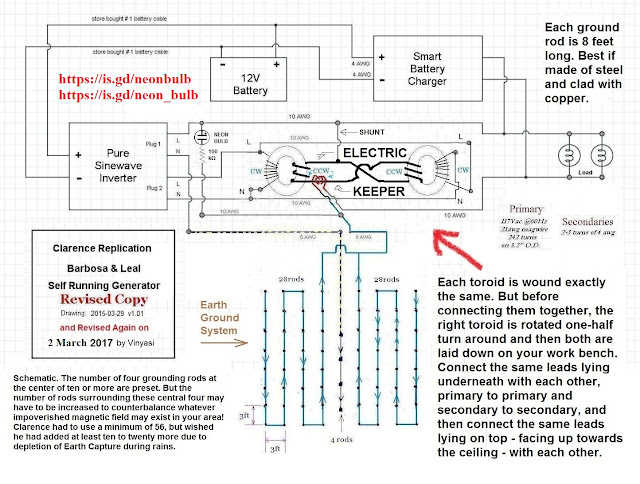Neon Bulb Placement is Predicated on its Role as a Negative Resistor
This applies to any overunity circuit whose behavior depends on the contribution which a gas discharge tube can impart to some or another part of the circuit to which this component is included.
I'm thinking of the Earth Captor of Barbosa and Leal. We want the Earth to become one gigantic negative resistor so that it will yield more amperage per increased resistance arising from additional demands made by a load (of appliances ;-). This, the neon bulb, or other appropriate sparking gap, can induce somehow within other components of the circuit to which it is attached including the load as well. But in the case of B&L, we especially want the volume of Earth in between the two sets of grounding rods to behave as a negative resistor so that whenever the load induces an increased resistance upon the Electric Keeper, in turn a demand for more amperage is imposed upon the Earth provided that the Earth can respond with a greater supply of amperage to the grounding rods. This will not happen if there is not enough grounding rods among the greater set of rods directly connected to the Captor Loop. But also if there is not enough geomagnetism in the area, or both. For we want the Earth to behave like the gas inside of the neon bulb. And we want the two sets of grounding rods to behave like the two electrodes inside of the neon bulb. The neon bulb can't provide abundant free energy on its own. Neither can the Earth. But the two together make for a splendid team work. And if the Lenz effect is neutralized between the two toroidal transformers flanking both sides of the Electric Keeper and loosely coupled to it, then only amperage will flow inside of the Electric Keeper. And since only amperage is being collected by the greater of the two sets of grounding rods, this whole system of enhancing a tiny input of power is very well designed by two excellent inventors, Nilson Barbosa and Cleriston Leal as successfully replicated by Clarence of Carolina, USA.
This applies to any overunity circuit whose behavior depends on the contribution which a gas discharge tube can impart to some or another part of the circuit to which this component is included.
I'm thinking of the Earth Captor of Barbosa and Leal. We want the Earth to become one gigantic negative resistor so that it will yield more amperage per increased resistance arising from additional demands made by a load (of appliances ;-). This, the neon bulb, or other appropriate sparking gap, can induce somehow within other components of the circuit to which it is attached including the load as well. But in the case of B&L, we especially want the volume of Earth in between the two sets of grounding rods to behave as a negative resistor so that whenever the load induces an increased resistance upon the Electric Keeper, in turn a demand for more amperage is imposed upon the Earth provided that the Earth can respond with a greater supply of amperage to the grounding rods. This will not happen if there is not enough grounding rods among the greater set of rods directly connected to the Captor Loop. But also if there is not enough geomagnetism in the area, or both. For we want the Earth to behave like the gas inside of the neon bulb. And we want the two sets of grounding rods to behave like the two electrodes inside of the neon bulb. The neon bulb can't provide abundant free energy on its own. Neither can the Earth. But the two together make for a splendid team work. And if the Lenz effect is neutralized between the two toroidal transformers flanking both sides of the Electric Keeper and loosely coupled to it, then only amperage will flow inside of the Electric Keeper. And since only amperage is being collected by the greater of the two sets of grounding rods, this whole system of enhancing a tiny input of power is very well designed by two excellent inventors, Nilson Barbosa and Cleriston Leal as successfully replicated by Clarence of Carolina, USA.















Comment